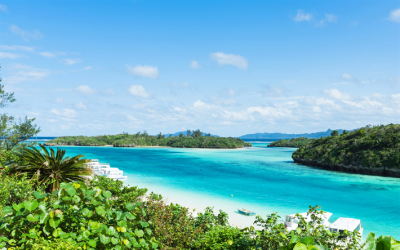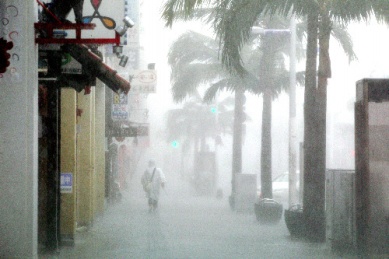
Okinawa has a subtropical climate. The average temperature in Okinawa is 22°C (72°F). It gets very humid here. In the mid-summer months, especially July and August, it is extremely hot. In winter, the temperature does not fall below about 10°C (50°F). To prepare for Okinawan summers visit this page: Combating Summer.
In the winter (Jan, Feb), Okinawa can get fairly cold because of strong northern winds whipping over the ocean and the frequent cloudy days. Okinawa is the windiest prefecture in Japan. On sunny and windless winter days, it can get warm, but for the most part you should plan to bundle up at the end of the year. Even JETs from countries with “real” winters will find Okinawan winters quite cold due to the wind. However, it does not snow and hail or sleet is rare.
May and June is the rainy season. Typhoon season starts in June and finishes at the end of November. Learn how to prepare for typhoons here: Typhoon Preparation.

Depending on what climate you are most accustomed to, the weather in Okinawa can be fairly pleasant, or extremely uncomfortable. The humidity is often very uncomfortable for people who are not used to high levels of moisture in the air. Don’t expect your hair to stay straight for longer than two minutes after straightening it! The extreme summer heat will be difficult for you if your homeland does not have similar heat. That said, most JETs do have air conditioners. If you have to buy a new AC unit, it might cost about ¥50,000 ($500–$100 installation, $400 AC) or more.
Some schools have AC and some do not. High schools are more likely to have AC than elementary or junior highs. If there is AC in your school, it might only be in the teachers’ room, or perhaps in both student and teachers’ rooms. The hallways will rarely ever be air-conditioned. Please prepare work clothes that is both professional and light and cool for the summer months.
Despite the cold Okinawan winters, central heating is nonexistent in Okinawa. Many JETs own a small electric heater to use in the winter months. This may seem a bit ridiculous for those who haven’t experienced Okinawan winters yet, but although the temperatures do not go down past 50°F/10°C, Japanese buildings are not built with insulation, so it does get chilly inside.
